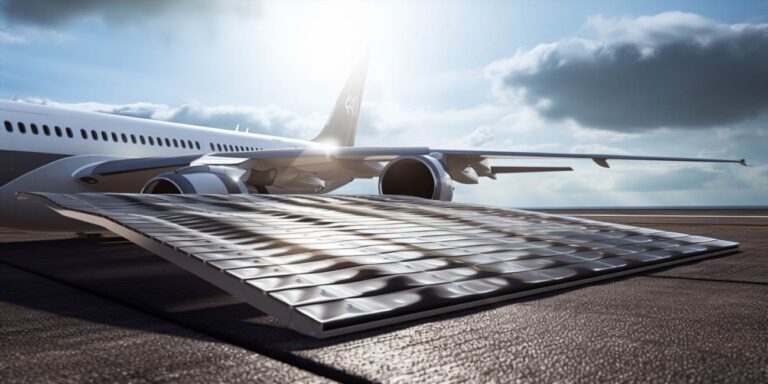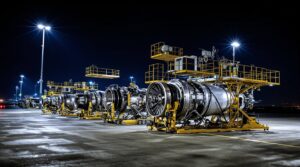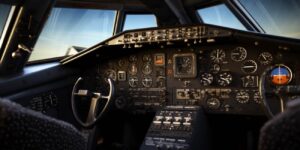Essentially, spoilers are designed to spoil the lift generated by the wings, and they serve a variety of functions. One of their primary roles is to assist in controlling the descent rate during the landing phase. By disrupting the airflow over the wings, spoilers increase drag and reduce lift, allowing the aircraft to make a controlled and gradual descent to the runway.
Now, let’s delve into the types of spoilers and their specific functions. There are several variations of spoilers, each serving a unique purpose in different phases of flight. One common type is the roll spoiler, which is primarily responsible for aiding in the lateral control of the aircraft. These spoilers are strategically placed on the wings and can be selectively deployed to assist in turning and banking.
Another noteworthy type is the speed brake, which, as the name suggests, is utilized to rapidly decrease the speed of the aircraft. Speed brakes are often deployed during the descent phase, helping the aircraft lose altitude while maintaining a controlled speed. This is particularly crucial in preparing for a smooth and safe landing.
Furthermore, some aircraft are equipped with ground spoilers, which automatically deploy upon touchdown. These spoilers enhance braking efficiency by increasing drag, aiding in the quick deceleration of the aircraft. This feature is especially valuable during landings on shorter runways or in adverse weather conditions.
It’s important to note that spoilers also play a role in enhancing safety. During certain emergency situations, such as an aborted takeoff, spoilers can be deployed to rapidly decrease lift and bring the aircraft to a halt. This capability is part of the comprehensive safety measures integrated into modern aircraft systems.
Spoilers role in increasing aircraft braking efficiency
In the realm of aviation engineering, the quest for optimal safety and performance never ceases. One critical aspect that often flies under the radar, quite literally, is the role of spoilers in enhancing aircraft braking efficiency. While these unassuming devices may seem inconspicuous on the wings of an aircraft, their impact on the braking system is nothing short of revolutionary.
Picture this: a sleek airliner hurtling down the runway at breakneck speed, preparing for touch down. As the wheels make contact with the tarmac, the immense kinetic energy built up during flight transforms into a challenge for the aircraft’s braking system. This is where spoilers step into the limelight, playing a pivotal role in not just slowing down the aircraft but doing so with precision and efficiency.
The primary function of spoilers during landing lies in disrupting the smooth airflow over the wings. When deployed, these devices create a sudden increase in drag, acting as speed brakes that aid in the rapid deceleration of the aircraft. This, in turn, alleviates the burden on the conventional braking mechanisms, such as wheel brakes and reverse thrust, contributing to overall safety and longevity of the braking system.
One might wonder, how do spoilers achieve this feat? The answer lies in their strategic placement and their ability to alter the aerodynamics of the aircraft during crucial phases of flight. Positioned on the upper surface of the wings, spoilers disrupt the lift generated by the wings, causing a controlled descent and ensuring the aircraft makes a smooth and controlled contact with the runway.
Moreover, the deployment of spoilers isn’t a one-size-fits-all affair. Pilots have the capability to selectively engage spoilers based on the specific requirements of the landing. This adaptability adds an extra layer of finesse to the braking process, allowing for nuanced adjustments depending on factors like runway length, weather conditions, and aircraft weight.
The effectiveness of spoilers in increasing aircraft braking efficiency becomes even more evident when considering emergency scenarios. In the unfortunate event of a rejected takeoff or an aborted landing, spoilers become instrumental in rapidly decelerating the aircraft, preventing potential disasters.
It’s worth noting that the integration of spoilers into the braking strategy isn’t a recent innovation. Over the years, as aviation technology has advanced, spoilers have evolved in design and functionality. Modern aircraft boast sophisticated spoiler systems that seamlessly integrate with other avionic systems, creating a harmonized approach to braking efficiency.
Spoilers helping pilots manage aircraft during takeoff
Spoilers play a crucial role in assisting pilots during various phases of flight, including takeoff. As the aircraft accelerates down the runway during the takeoff roll, precise control becomes paramount. The deployment of spoilers is a strategic maneuver to manage the aircraft’s speed and optimize its performance.
During the initial moments of takeoff, the aircraft is on the runway, and the pilot carefully monitors the acceleration. As the speed increases, the pilot gradually initiates the rotation phase. This is a pivotal moment as the aircraft transitions from a ground roll to an ascent. Spoilers can be selectively deployed to enhance control during this critical rotation phase.
The lift generated during takeoff is a result of the aircraft’s wings generating sufficient aerodynamic force to overcome gravity. Spoilers, when deployed, disrupt the smooth airflow over the wings, reducing the lift momentarily. This controlled reduction in lift aids in a more predictable and manageable rotation as the aircraft climbs into the sky.
As the aircraft begins its ascent, spoilers continue to contribute to the overall control and stability. The climb phase is characterized by a gradual increase in altitude, and maintaining the desired climb speed is crucial for a safe and efficient ascent. Pilots judiciously adjust the spoilers to optimize the aircraft’s performance, ensuring a steady climb speed that aligns with operational requirements.
The strategic use of spoilers extends beyond the initial takeoff phase. Pilots continuously assess the aerodynamic conditions and adjust spoiler deployment to fine-tune the aircraft’s behavior. This level of control is particularly essential during climb, where the aircraft is ascending to its cruising altitude.
Using spoilers for aircraft stability and control in flight
Flight is a delicate dance between aerodynamic forces and mechanical systems, where stability and control play pivotal roles. Understanding how aircraft utilize spoilers for precise roll, yaw, and pitch control is essential for ensuring a smooth and safe journey through the skies.
In the realm of aviation, the term stability is synonymous with predictability. It refers to an aircraft’s inherent tendency to return to a steady state after a disturbance. Achieving optimal stability involves a delicate balance, and spoilers contribute significantly to this equilibrium.
Starting with roll, spoilers are aerodynamic devices deployed on the wings to control the lateral movement of the aircraft. When executing a roll, the spoilers on one wing extend while the opposite side retracts, inducing a controlled tilt. This manipulation of aerodynamic forces enables precise roll control, allowing the pilot to bank the aircraft smoothly without sacrificing stability.
Meanwhile, addressing yaw involves maintaining the aircraft’s heading. Here, the use of rudders is complemented by the deployment of spoilers on the wings. By selectively activating spoilers on one side, a gentle yaw can be induced, aiding in directional adjustments. This integrated approach ensures that yaw adjustments are seamlessly integrated into the broader framework of stability control.
When it comes to pitch, spoilers contribute to both ascent and descent. During descent, spoilers are raised, creating additional drag and reducing lift. This controlled increase in drag facilitates a gradual descent without compromising stability. Conversely, when ascending, spoilers retract to minimize drag, allowing the aircraft to climb efficiently while maintaining stability in its pitch orientation.
The orchestration of these stability control mechanisms is a testament to the intricate engineering behind modern aircraft. Pilots rely on a finely tuned interplay of spoilers, ailerons, and rudders to navigate the complex three-dimensional space with precision. It’s a ballet of aerodynamics and technology, where each movement is calculated to ensure a harmonious dance through the skies.
As we delve deeper into the nuances of aircraft stability control, the integration of spoilers emerges as a critical element. They are not mere appendages on wings but rather the conductors orchestrating the symphony of roll, yaw, and pitch. Their judicious use ensures that the aircraft responds predictably to pilot commands, maintaining an exquisite balance between stability and dynamic maneuverability.






